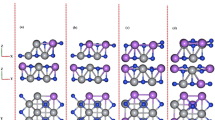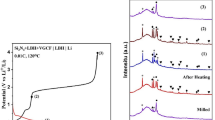Abstract
An investigation of Li-M (M: Si, Sn) components using density functional theory (DFT) is presented. Calculation of total energy, structural optimizations, bulk modulus and elastic constants with Li-Sn, Li-Si are performed through DFT calculations. From the comparable study of Li-Sn and Li-Si, it is found that silicon experience drastic mechanical degradation during lithiation than tin-based Li-Sn components. With increasing lithium net charge transfer to metals, the filling of anti-bonding orbital makes M-M covalent bonding weak ionic bonding in both Li-Si and Li-Sn. However, the difference of change of mechanical degradation during lithiation in Li-Si and Li-Sn results from the sensitivity of transition of covalent bonding. We check this from sharp decreasing of yield stress in Li-Si case. Furthermore, we simply make up amorphous Si cell with an additional Li atom at the center of the largest void to simulate the lithiation of amorphous silicon. Volume expansion of amorphous silicon cell agrees with the experiment observation and theoretical data of Li-Si compounds.
Similar content being viewed by others
Abbreviations
- E(V,e):
-
total energy of the system
- Cijkl :
-
elastic stiffness tensor
- eij :
-
deformation applied strain
- Y:
-
Young’s modulus
- K:
-
Bulk modulus
- G:
-
Shear modulus
- v:
-
Poisson’s ratio
References
Tarascon, J. M. and Armand, M., “Issues and challenges facing rechargeable lithium batteries,” Nature, Vol. 414, No. 6861, pp. 359–367, 2001.
Park, C. M., Kim, J. H., Kim, H., and Sohn, H. J., “Li-alloy based anode materials for li secondary batteries,” Chem. Soc. Rev., Vol. 39, No. 8, pp. 3115–3141, 2010.
Golmon, S., Maute, K., Lee, S. H., and Dunn, M. L., “Stress generation in silicon particles during lithium insertion,” Appl. Phys. Lett., Vol. 97, No. 3, Paper No. 033111, 2010.
Key, B., Bhattacharyya, R., Morcrette, M., Seznec, V., Tarascon, J. M., and Grey, C. P., “Real-time nmr investigations of structural changes in silicon electrodes for lithium-ion batteries,” J. Am. Chem. Soc., Vol. 131, No. 26, pp. 9239–9249, 2009.
Chevrier, V. L., Zwanziger, J. W., and Dahn, J. R., “First principles study of li-si crystalline phases: Charge transfer, electronic structure, and lattice vibrations,” Journal of Alloys and Compounds, Vol. 496, No. 1–2, pp. 25–36, 2010.
Stearns, L. A., Gryko, J., Diefenbacher, J., Ramachandran, G. K., and Mcmillan, P. F., “Lithium monosilicide (lisi), a lowdimensional silicon-based material prepared by high pressure synthesis: Nmr and vibrational spectroscopy and electrical properties characterization,” J. Solid State Chem., Vol. 173, No. 1, pp. 251–258, 2003.
Limthongkul, P., Jang, Y. I., Dudney, N. J., and Chiang, Y. M., “Electrochemically-driven solid-state amorphization in lithiummetal anodes,” J. Power Sources, Vol. 119, pp. 604–609, 2003.
Kubota, Y., Escano, M. C. S., Nakanishi, H., and Kasai, H., “Crystal and electronic structure of li15si4,” J. Appl. Phys., Vol. 102, No. 5, Paper No. 053704, 2007.
Obrovac, M. N. and Christensen, L., “Structural changes in silicon anodes during lithium insertion/extraction,” Electrochem. Solid St., Vol. 7, No. 5, pp. A93–A96, 2004.
Kang, K., Lee, H. S., Han, D. W., Kim, G. S., Lee, D., Lee, G., Kang, Y. M., and Jo, M. H., “Maximum Li storage in Si nanowires for the high capacity three-dimensional Li-ion battery,” Appl. Phys. Lett., Vol. 96, No. 5, Paper No. 053110, 2010.
Chan, T.-L. and Chelikowsky, J. R., “Controlling diffusion of lithium in silicon nanostructures,” Nano Letters, Vol. 10, No. 3, pp. 821–825, 2010.
Deshpande, R., Cheng, Y. T., and Verbrugge, M. W., “Modeling diffusion-induced stress in nanowire electrode structures,” J. Power Sources, Vol. 195, No. 15, pp. 5081–5088, 2010.
Gao, Y. F. and Zhou, M., “Strong stress-enhanced diffusion in amorphous lithium alloy nanowire electrodes,” J. Appl. Phys., Vol. 109, No. 1, Paper No. 014310, 2011.
Liu, X. H., Zheng, H., Zhong, L., Huang, S., Karki, K., Zhang, L. Q., Liu, Y., Kushima, A., Liang, W. T., Wang, J. W., Cho, J.-H., Epstein, E., Dayeh, S. A., Picraux, S. T., Zhu, T., Li, J., Sullivan, J. P., Cumings, J., Wang, C., Mao, S., Ye, Z. Z., Zhang, S., and Huang, J. Y., “Anisotropic swelling and fracture of silicon nanowires during lithiation,” Nano Letters, Vol. 11, No. 8, pp. 3312–3318, 2011.
Zhao, K. J., Pharr, M., Cai, S. Q., Vlassak, J. J., and Suo, Z. G., “Large plastic deformation in high-capacity lithium-ion batteries caused by charge and discharge,” J. Am. Ceram. Soc., Vol. 94, No. 28712, pp. S226–S235, 2011.
Chevrier, V. L., Zwanziger, J. W., and Dahn, J. R., “First principles studies of silicon as a negative electrode material for lithium-ion batteries,” Can. J. Phys., Vol. 87, No. 6, pp. 625–632, 2009.
Shenoy, V. B., Johari, P., and Qi, Y., “Elastic softening of amorphous and crystalline li-si phases with increasing li concentration: A first-principles study,” J. Power Sources, Vol. 195, No. 19, pp. 6825–6830, 2010.
Kim, H., Chou, C. Y., Ekerdt, J. G., and Hwang, G. S., “Structure and properties of li-si alloys: A first-principles study,” J. Phys. Chem. C, Vol. 115, No. 5, pp. 2514–2521, 2011.
Winter, M. and Besenhard, J. O., “Electrochemical lithiation of tin and tin-based intermetallics and composites,” Electrochim. Acta, Vol. 45, No. 1–2, pp. 31–50, 1999.
Sangster, J. and Bale, C. W., “The li-sn (lithium-tin) system,” J. Phase Equilib., Vol. 19, No. 1, pp. 70–75, 1998.
Courtney, I. A., Tse, J. S., Mao, O., Hafner, J., and Dahn, J. R., “Ab initio calculation of the lithium-tin voltage profile,” Physical Review B, Vol. 58, No. 23, pp. 15583–15588, 1998.
Stournara, M. E., Guduru, P. R., and Shenoy, V. B., “Elastic behavior of crystalline li-sn phases with increasing li concentration,” J. Power Sources, Vol. 208, pp. 165–169, 2012.
Blochl, P. E., “Projector augmented-wave method,” Physical Review B, Vol. 50, No. 24, pp. 17953–17979, 1994.
Kresse, G. and Furthmuller, J., “Efficient iterative schemes for ab initio total-energy calculations using a plane-wave basis set,” Physical Review B, Vol. 54, No. 16, pp. 11169–11186, 1996.
Chung, D. H. and Buessem, W. R., “The Voigt-Reuss-Hill (VRH) Approximation and Elastic Moduli of Polycrystalline ZnO, TiO2 (Rutile), and α-Al2O3,” J. Appl. Phys., Vol. 39, No. 6, pp. 2777–2782, 1968.
Wortman, J. J. and Evans, R. A., “Young’s modulus, shear modulus, and poisson’s ratio in silicon and germanium,” J. Appl. Phys., Vol. 36, No. 1, pp. 153–156, 1965.
Kluge, M. D., Ray, J. R., and Rahman, A., “Molecular dynamic calculation of elastic-constants of silicon,” J. Chem. Phys., Vol. 85, No. 7, pp. 4028–4031, 1986.
Kluge, M. D. and Ray, J. R., “Elastic-constants and density of states of a molecular-dynamics model of amorphous-silicon,” Physical Review B, Vol. 37, No. 8, pp. 4132–4136, 1988.
Chou, C. Y., Kim, H., and Hwang, G. S., “A comparative firstprinciples study of the structure, energetics, and properties of lim (m = si, ge, sn) alloys,” J. Phys. Chem. C, Vol. 115, No. 40, pp. 20018–20026, 2011.
Lee, S. S., Heo, D. E., and Lee, J. K., “Modified damage initiation criterion for the cohesive boundary element,” Int. J. Precis. Eng. Manuf., Vol. 11, No. 4, pp. 577–581, 2010.
Author information
Authors and Affiliations
Corresponding author
Rights and permissions
About this article
Cite this article
Moon, J., Cho, K. & Cho, M. Ab-initio study of silicon and tin as a negative electrode materials for lithium-ion batteries. Int. J. Precis. Eng. Manuf. 13, 1191–1197 (2012). https://doi.org/10.1007/s12541-012-0158-4
Received:
Accepted:
Published:
Issue Date:
DOI: https://doi.org/10.1007/s12541-012-0158-4




